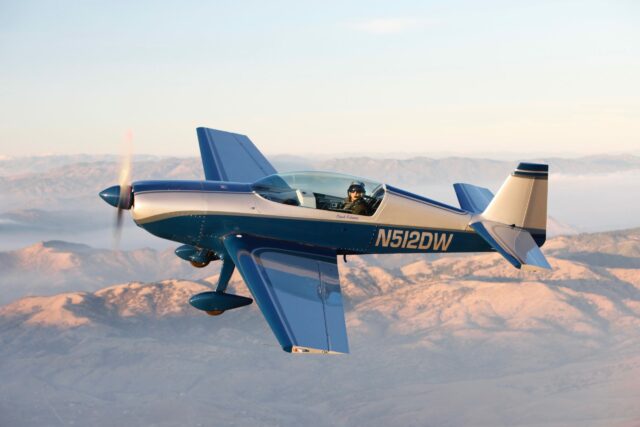A Side-by-Side Analysis of the Fatal Extra E300L Crash at Las Cruces
A local pilot’s side-by-side video comparison shows the same aerobatic sequence performed at an airshow in New Mexico on two consecutive days: a successful performance on Saturday synchronised to Sunday’s fatal crash.
The Las Cruces Air & Space Expo ended early on Sunday, the 20th of October, after a heartbreaking crash during a solo aerobatic performance, destroying the aircraft and killing the pilot. Chuck Coleman, well-known in the US as an air show pilot, aerospace engineer and flight instructor, was killed in the crash. Some headlines have referred to him as the Top Gun flight instructor, as he trained the actors on aerobatics and the effects of g-forces for the Hollywood blockbuster Top Gun: Maverick, flying 140 flights with the actors to prepare them for flying in the Navy F-18 Hornets. Coleman’s website says that he has over 10,000 hours total flight time with over 4,100 of those in the Extra Flugzeugbau 300 series.

His Extra EA-300L was registered in the US as N512DW in 2009. The Extra 300 is a popular aerobatic plane designed by German aerobatic pilot, Walter Extra, and manufactured by Extra Flugzeugbau. The 300L is the most popular version of the 300, which has the wings mounted at the bottom of the fuselage with a slightly shorter wing span and improved ailerons. With one onboard, such as for aerobatic shows, the 300 is stressed for plus/minus 10G. Coleman’s website offers rides and flight instruction in his Extra 300L, which the site says is stressed for plus/minus 8G with two onboard — enough to include reassurance in the FAQ that Coleman will slow down if the passenger is feeling sick from the aerobatics.
Coleman’s solo display had been going on for about four minutes and was on what a commenter on PPRuNe described as a “gyroscopic double tumble“.
Full left foot and full forward slight left stick and the aircraft tumbles starting at around 100Kts, The problem is that after the maneuver you are left hanging in the air like a dead weight ( No speed), No potential no kinetic energy, Energy from engine will not be enough, you need to dive to regain speed. Not enough height available.
At 14:32 local time, spectators said that the aircraft appeared to tumble and then crashed nose down into the ground.
The pilot performed the same routine on both days of the airshow. Local pilot Brian Murray videoed the entire routine on his phone on Saturday and synched his video of the manoeuvre, as successfully flown, to a video of the loss of control on the Sunday. You can see this on his YouTube video at the 2:30 mark (people reading on the mailing list may need to click through to the website to see the video).
This shows the Extra 300L flying the routine on Saturday on the left and then a closer video of the routine on the right, at full speed and half speed. We can see the aircraft enter a double roll and then tumble twice. Saturday’s footage shows the aircraft continue the tumble and pull out but in Sunday’s footage, the aircraft appears to slow and exit the tumble early. It looks to me like there’s an attempt to pull up and recover but the aircraft is just too close to the ground.
There is some speculation that he started the manoeuvre lower on the accident flight than the day before. Certainly from the videos, it seems that on both days, the tumble is executed at a surprisingly low height above the ground. Whatever else happened, this eroded his margin for error or mechanical issues, as he did not allow himself much height for recovery.
The NTSB is investigating. So far, they have simply released that the aircraft impacted terrain one-half mile west of Las Cruces International Airport.








If I see this correctly, on Saturday he tumbled until upright, and dives to fly off. On Sunday, he comes out of the tumble inverted, and attemps a half loop?
Coming into the tumble, he seems a little slower on Sunday, but maybe I’m imagining that.
Does anyone agree?
It’s hard to be sure what was different because the two videos seem to be not quite synced, but it looks like he was rolling somewhat less evenly on Sunday, then fell off to the side, or possibly yawed, in the middle of the forward tumble; notice there are a couple of frames where the plane’s belly is facing the camera. Coming out inverted (followed I think by a snap roll rather than a half loop) might have been caused by this added twist, or by his attempt to abort the maneuver before finishing the second tumble. I can’t be sure of anything except the odd attitude on Sunday, and the Saturday video is small enough that I’m not sure the same thing doesn’t happen, just later, as he comes out of the maneuver facing the camera after starting facing left.
I also see that the smoke trail is different between the initial rolls and the start of the tumble — there’s a clear loop in the trail on Saturday, and just a hiccup on Sunday — but I don’t know anything about this maneuver and so can’t guess whether it’s significant. Outside of this, the start of the tumble seems no more delayed than the start of the rolls, so the difference may just be that the videos aren’t precisely synced.
Somebody may have shot better video (e.g., with a camera with optical zoom, rather than a phone), or enhancement might get clearer results.